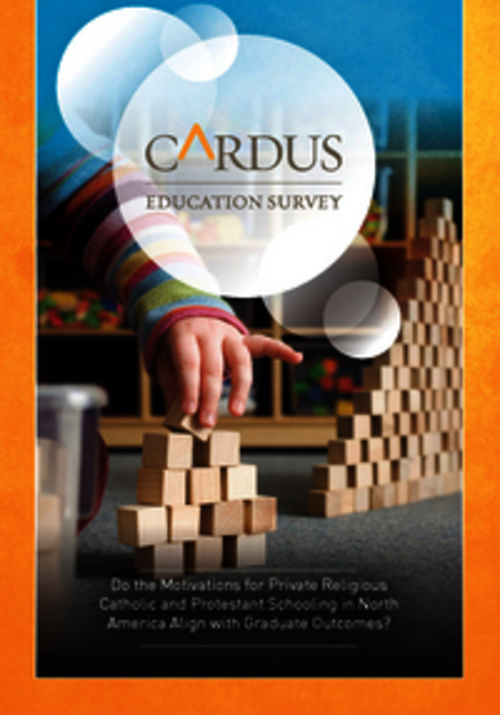The recent appointment of the Ontario College of Trades’ board of governors has drawn mixed reaction from the construction industry and renewed concerns about the new entity for some.Karen Renkema, Ontario Road Builders’ Association Director of Government Relations, said there’s still concern over the transparency and accountability of the College and said there isn’t a lot of information being shared with stakeholders. ... the recent report by Hamilton-based think-tank Cardus, called College of Trades: An Impossible Institution, expressed “very real” concerns about the structure of the College and its ability to properly function and serve the industry. The OGCA will bring the report to the new minister of Training, Colleges and Universities, Glen Murray. Read the whole news story on Cardus' College of Trades report, here.

Mixed reaction from Ontario construction associations to College of Trades appointments
November 10, 2011

Menzies: Nurturing the Conversations that Hold Us Together
Among the great joys of my life were the dinner conversations shared with my father. They swirled in a world of politics, philosophy, theology, western aspiration/alienation, the meaning of change and the precious nature of useful tradition. Not everyone was as fascinated by the profundity of our thinking as we were, of course, but I miss their ebb, their flow, their depth and, yes, their provocation. Dad died two years ago, and while I remain lonely for his voice, except when I hear it in mine, that which he imbued in me—a fascination with the vitality of the public square—has only quickened. I'd like to think the same wonder flows yet in the veins of my children who, while their views may diverge dramatically, share in the common life of a family. The branches of that family stretch from coast to coast and across the Atlantic whence they all once came. Most of its members could speak for years on the issues that fascinated my father and me and never agree on a single point. Most would probably just as soon not speak of them at all. They vote in different ways, have a variety of views on God and see the country and the world through multiple windows of perception. But, when they gather as they did this summer for two family weddings, their differences are set aside (or at least tolerated) because they share a common life and love. Societies are founded in the common life of a family, formed between mother and child in the womb and nurtured ever forward. The bonds become looser and more strained as their borders expand from the private, nuclear unit and that, in turn, demands the cultivation of the common ground that is vital to a healthy public square. This is why the new Cardus periodical publication Convivium (faith in our common life), is so vital to the sustenance—some would say resuscitation—of the conversations that hold us together. Its publisher is a friend and former colleague, Peter Stockland, a past editor of Reader's Digest, editor-in-chief of the Montreal Gazette and (surely the most distinguished item on his resume) former editorial page editor of the Calgary Herald. Its editor is Bishop Carroll graduate Father Raymond de Souza, who manages to maintain a single persona despite multiple roles as economist, Kingston-area parish priest, Roman Catholic chaplain at Queen's University and regular columnist for the National Post. Its aspiration is to be a useful vehicle in the restoration of a rich public square in which all perspectives—including those based in faith—feel welcome and engage in reasoned and persuasive debate. As Father de Souza said recently at an event in Calgary, once we lose faith in our common life, all we have left is fundamentalism. And fundamentalism in all its manifestations—religious, ideological and secular—has nothing to offer to debate. It eschews reason and persuasion in its definition to force itself onto others. It is, if you catch my drift, an unhelpful and extreme resolution to the tension between freedoms and order that is the hallmark of mature, stable liberal democracies. Convivium (a place of conviviality such as the dinner table once shared with Dad) clearly has its feet founded in the Roman Catholic philosophical tradition, and over the years, Stockland and de Souza have established their pedigree. Asking if Stockland is inclined to a conservative view is, it must be said, very much a "is the Pope Catholic?" kind of question. Yet both men are aware through their histories and through the nature of the Convivium project itself that polemic requires the enrichment of diversity. Thus were their pluralistic aspirations laid bare with the inclusion in their premier edition of Bill Blaikie's lament for the social gospel movement that once so inspired the Canadian left. "Actions...are very rarely rooted in a spontaneous idea," says Cardus president Michael Van Pelt. "Most often they're rooted in ideas that have been bandied about for many years. Poetry is written about them. Debates rage in the pub over them. And then suddenly, they're done. But the conversation came first. We want Convivium to be a place where that conversation takes place in Canada." It is, for now, unlikely that this project will make the custodians of these and other similar pages tremble, but it may inspire. Its aim is to revive the public nature of intellectual traditions that were once the meat and drink of our discourse. There is little evidence, based on its initial edition, that it will do anything less.
November 9, 2011

The Vatican and Occupy Wall Street
Pope Benedict may or may not bless the Occupy Wall Street movement. But an Eastern European former Marxist atheist intellectual has told protesters that they should really preoccupy themselves with the Holy Spirit. Leading up to November’s G20 economic meeting in France, and as the Occupy Wall Street movement entered its second month, media whoop-whoop made it sound like Benedict’s arrival at the barricades was imminent. The story turned out to be a torque job so clumsy it would make an apprentice mechanic at Dollar Bill’s Easy Autos blush. Upon release of a document by the Pontifical Council for Justice and Peace calling for changes in regulation of global financial markets, Cardinal Peter Kodowo Appiah Turkson was asked if the Vatican is aligning itself with the protest that began Sept. 17 in New York and has spread to other cities, including Toronto, Calgary, Vancouver and Montreal. The cardinal prudently replied that all people have every right to demand business be done differently, and the right applies as much on Wall Street as anywhere. No Benedict. No barricades. Naturally, reporters rushed to file stories claiming that what wasn’t said was actually what was said. It was left to their audiences to conclude, yet again, that truth is an infinitely variable concept in the journalistic mind. Still, there was a positive to the predictable media inflation-deflation cycle. It awakened some reporters to Benedict’s 2009 encyclical Caritas in Veritate, which articulates the very model of economic justice that the naïve and incoherent OWS mobs gurgle to express. To the extent the Holy Father remotely “blessed†the occupation movement, he did so two years before it was even born and, by extension, through Catholic social teaching dating back to Rerum Novarum in May, 1891. Such prudential distancing was a laudable contrast to camera- mongering celebrities who showed up hoping to get shine time for their “person-of-the-people†personas. Among them, of course, was moviemaker Michael Moore, that roly-poly panjandrum of pseudo-populist poppycock. Moore styles himself a documentary maker. His work relates to documented truth as a man on a train relates to the lights of a prairie town at night. There’s the same sliding recognition of something passing by outside, and then the dark again. Being a mere passerby did not dampen Moore’s urge to speak for #OWS, as the movement was immediately twitterized. He happily appeared on TV interviews in the United States and Britain championing the cause about which, as with his films, it turned out he knew little. Pressed by an interviewer on how the occupiers would replace capitalism, Moore blinked like an owl in an optometrist’s chair and elucidated: “Capitalism is evil. It has to be ended.†Well, that clears things up. Actually, it fell to the Slovenian academic and cultural critic Slavoj Zizek to clarify what the OWS movement should be, which might be very different from what it might be. Zizek is a rock star philosopher. Not just a rock star given to “philosophizing†like U2’s Bono, but a renowned academic philosopher who is also the clown prince of social media. In one YouTube clip, he verbally spanks some privileged Western vegans for their “decadence†in refusing to eat meat. In another, he meditates on the cultural significance of the direction toilet water drains in different parts of the world. In his serious writing, he is an atheist obsessed with understanding St. Paul. Speaking to OWS protesters in New York, Zizek warned against turning their days occupying Wall Street into down payments on nostalgia. “Carnivals come cheap,†he said, challenging them to take seriously the serious work they have begun. Then he put that work in a religious, indeed explicitly Christian, frame. “The conservative fundamentalists who claim they are ‘really’ Americans have to be reminded of something: What is Christianity? It’s the Holy Spirit. What is the Holy Spirit? It’s an egalitarian community of believers who are linked by love for each other and who only have their own freedom and responsibility to do it. In this sense, the Holy Spirit is here now, and down there on Wall Street are bankers who are worshipping blasphemous idols.†Who knows when a public intellectual of Zizek’s stature last used such language at a protest rally? Yet his words will hang in the air — at least until Pope Benedict really brings his blessing to the barricades.
November 3, 2011

Calgary Herald editorial on making room for worship in the city
A few years ago, the city updated its City Centre Plan, foreseeing as many as 70,000 more people living in the city core. The think-tank, Cardus, thankfully read the report and noticed that places of worship were completely ignored in the report except with regard to conservation of heritage sites. So, it's important for us to have this debate. Read the rest of the article here.
October 24, 2011

The Cardus Survey results – part 2
To read the full article, click here .
October 22, 2011

Finding a place for God in the city
The newest downtown office building now rises above all others, the crescent-shaped building called The Bow. When completed next year, civic leaders intend it to be more than a symbol of Calgary's economic power. The hope is that it will lead a revitalization of the east side of downtown, where a new office tower hasn't gone up for 25 years. The Bow will be a Calgary landmark to be sure, but what kind of downtown will it preside over? What constitutes downtown development was the subject of an innovative report released here last week by Cardus, a think-tank that seeks to bring the Christian tradition to bear on our social architecture, as they put it. (Though I am a senior fellow at Cardus, I was not involved in this project, except to promote its launch.) The "Calgary City Soul" project asks a simple question: Are places of worship important in downtown development? Visions for downtown usually include office towers, high-end retail, residential buildings and space for parks and culture - libraries, museums, opera houses, theatres and art galleries. In recent years, for both commuting and environmental reasons, a desire has emerged to increase downtown density, so greater attention is now paid to how more people might live downtown. Where will the schools be? Will there be markets in walking distance? A few years back the City of Calgary updated its City Centre Plan, laying out what would be needed over the next decades if Calgary were to add as many as 70,000 people to the city core. It was the type of comprehensive planning document that is massively influential - and rather dull. But the folks at Cardus read such stuff and noticed that places of worship were totally ignored in the planning process - not even mentioned, except as a heritage conservation issue. Perhaps it was thought that none of the new downtown residents would be churchgoers. Or more likely, that whatever the churches had to offer would not contribute to downtown development. The Calgary City Soul project (Cardus.ca) argues that such an oversight was a critical failure. "Beliefs may be private or personal matters, but the institutions that nurture them have long been and remain public and part of, not apart from, the secular society represented by governments," the report argues. "Faith institutions have long played a critical role in the social fabric of vital cities. The effectiveness and efficiency of these institution's social services often surpasses what can be delivered by govern-ment agencies, owing in part to the very localized and socially embedded nature of the service delivery represented by faith institutions." Without the churches downtown, who will look after the suffering on the streets? The same day the Cardus report was released, Mayor Naheed Nenshi was at a morning faith breakfast, speaking about the critical role of religious institutions in the city's homelessness project. The data gathered by the report make it clear that faith-based institutions of social service are critical in Calgary, as they are in many other cities. Often it is the church shelters and programs which are the last resort in an emergency. So it makes good civic sense to plan creatively for churches, synagogues, temples and mosques downtown. Megaprojects like The Bow will bring a lot of new investment downtown, but precisely these new office, retail and residential projects - most of them highend - drive up the cost of being downtown. Churches are not great revenue generators, especially downtown where populations are transient and the physical plant is likely old and expensive to maintain. Without a vision that makes room for religious congregations downtown, the forces of "renewal" will slowly squeeze them out. Good social policy attempts to keep them in. Yet it is more than just good social policy. Religion downtown is not just about caring for the bodies of those who are on the streets. It is about the soul of the city. A city that has no room in its heart for the things of God is simply a less human city. Busy and productive it may be, but lacking an essential purpose and a deeper meaning for all the work. The grandest street in the world, Fifth Avenue in New York, features the noblest of human culture - the New York Public Library - and the rather crass Trump Tower - within a few blocks of each other. But were it not for St. Patrick's Cathedral between them, the whole street would be impoverished. The skyscrapers are not the only things that should point the human spirit toward the heights.
October 20, 2011

Jonathan Chaplin publishes, Multiculturalism: A Christian Retrieval
Recent years have seen an astonishingly rapid volte face regarding multiculturalism in Britain. Once political orthodoxy, it is now almost a by-word for segregation, exclusion and security threats. In this report, Jonathan Chaplin argues that in our haste to reassess multiculturalism in the light of evidence of its darker sides, we must not lose sight of its indispensable contribution to realising a just society. Tracing the history of multiculturalism and clarifying precisely what is at stake in the debate, Chaplin offers a vision of "multicultural justice", drawn from the resources of Christian social thought, but accessible and persuasive to those outside of the Christian faith. To read this report in full, click here.
October 20, 2011

Shooting Up on Power
The Harper government is spending $28 million to have middle-aged jumbotron-sized gentlemen dress up as soldiers and re-enact the War of 1812. Meanwhile, Canada’s Parliament, 2011, has just suffered an assault by the provinces and the Supreme Court that, unless beaten back, overturns the constitutional order of Confederation. On September 30, Canada’s highest court handed down its decision in the Insite case. The judgment ostensibly involved a so-called safe injection site in Vancouver where addicts can shoot up street drugs such as heroin. The federal government had ordered a review of the experimental facility and was leaning toward closing it down. Read the rest of the article here.
October 19, 2011

Private Non-Religious Schools
To read the full article, click here .
October 17, 2011
